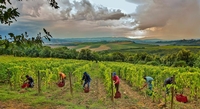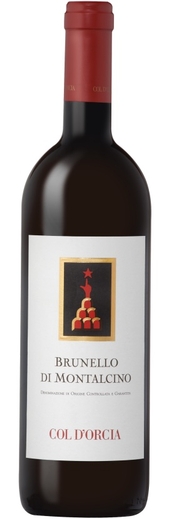 production? This idyllic Old-world Village rises from the Tuscan valley, just a short distance south of Siena, framed with lush vineyards, forest, and craggy dirt roads and trails along its slopes. Surrounded by myriad hills and Tuscany’s highest mountain peak, Monte Amiata, Montalcino is a bastion of architectural history bound by Medieval fortress and castle walls, ivory, and pink-tinged villas and stone farmhouses.
production? This idyllic Old-world Village rises from the Tuscan valley, just a short distance south of Siena, framed with lush vineyards, forest, and craggy dirt roads and trails along its slopes. Surrounded by myriad hills and Tuscany’s highest mountain peak, Monte Amiata, Montalcino is a bastion of architectural history bound by Medieval fortress and castle walls, ivory, and pink-tinged villas and stone farmhouses.
Long before it had earned its status as a revered winemaking region, this rural city has been home to a range of agricultural bounty known for everything from mushrooms and asparagus to wild boar and local honey. Early records of red wine known as “Brunello” date back as far as the 14th century. And though wine production has been an integral part of its historic culture—with sweet Moscadello wines among its prized offerings—it wasn’t until the mid-20th century that wines made from a particular local clone of Sangiovese were rising in quality and esteem. In 1960, Montalcino earned its status as a Denominazione di Origine Controllata (DOC), and as investment and focus continued through the 1970s, the region’s quality credentials were raised to Denominazione di Origine Controllata e Garntita (DOCG) in 1980, the first Italian wine region to do so. Today there are more than 250 producers of Brunello di Montalcino, many of which are small, family estates, though there are larger, well-established estates as well.
Shielded by the nearby Monte Amiata, Montalcino is the warmest growing region in Tuscany and the driest, yielding grapes with higher ripeness that are often picked up to a week before harvest begins in nearby areas such as Montepulciano. Vineyard plantings range in altitude from 300 feet to more  than 1,640 feet. With a requirement of a minimum of two years of oak aging, and cellar aging in bottle for five years after harvest, wine styles vary from finessed and elegant to generous and brawny.
than 1,640 feet. With a requirement of a minimum of two years of oak aging, and cellar aging in bottle for five years after harvest, wine styles vary from finessed and elegant to generous and brawny.
The variation in soils and microclimates among vineyards has led to a growing trend to drill down deeper into site and vineyard designation. In recent years, the region has seen more than 20 percent of its producers gain certification as organic or biodynamic, with many more in the process of transition.
I recently had a chance to experience some of the deliberate attention to detail and quality of this region through the lens of Col d’Orcia, with estate owner Count Francesco Marone Cinzano leading a virtual tasting.
As one of the original estates of Montalcino and now the largest certified organic estate in Tuscany, Col d’Orcia is a leader in Brunello di Montalcino, helping to define and promote one of Italy’s most prestigious wine regions. Tradition, integrity, and sustainability are the pillars of the estate, whose classic style wines are celebrated worldwide.
Located in the south-central part of the DOCG, between the hills of the Orcia River and the village of Sant’Angelo in Colle, the estate’s name translates to “the hill overlooking the Orcia River.” Col d’Orcia has an agricultural history dating back to the 14th century. In 1973, the property was purchased from the Fancheschi family, who had managed the farm for nearly a century, by the Cinzano family. As part of the pioneering effort to establish the region as a premium winegrowing region, the Cinzano family expanded the existing vineyards to more than 70 hectares. In the preceding year, the family would invest heavily into research and development of the land towards organic and biodynamic practices, earning organic certification in 2010 and transitioning towards biodynamic certification in 2018. Today, more than 150 hectares of estate vineyard are planted in loose limestone and marl soils at an elevation of about 1,500 feet.
In hearing from Cinzano during the tasting, it was clear that his commitment to the land was a true continuation of the philosophy of the humble family farmers who came before him, balanced with a deliberate desire to explore its potential and foster its future. The sprawling estate is no small feat to manage. It was endearing to hear about the many families employed by the estate that live on-site in the various farmhouses that have been renovated into modern homes. In such an extraordinary year of hardship and strife during the global pandemic, Cinzano recounted the great camaraderie among the families on the estate who essentially created their own social bubble, continuing to work the farm and lean into their tight-knit community.
We tasted three wines selected by Cinzano including the 2016 Brunello di Montalcino, the 2013 Poggio Al Vento Brunello di Montalcino Riserva DOCG, and the 2015 Olmaia Sant’ Antimo Cabernet DOC. Each vintage was particularly stellar for the region, with 2016 marked by a mild winter and a rainy spring, 2015 was moderate with sufficient spring rains and average temperatures, and 2013 was characterized as a welcome, mild growing season following a dramatic drought in 2012.
Cinzano’s guidance through the tasting was both instructive and insightful, illuminated more so by family and community anecdotes along the way. Though the tasting was only a small snapshot of Brunello di Montalcino, through the eyes of only one of its many top producers, the experience was a great reminder of all that this tiny little region has to offer.
2016 Brunello di Montalcino DOCG: A generally wet spring influenced a gradual rise in temperatures during the growing season, allowing grapes to slowly coast to ripeness. Following an 18-day fermentation in stainless steel tanks and aging in a range of 25, 50, and 75 hectoliter Slavonian and French casks, the wine aged for an additional year in bottle before release. A sturdy wine in its relative youth, the rich red cherry and plum aromas are ripe and luscious, backed by notes of sautéed mushroom, cocoa, and vanilla. The concentrated color and tannin in this wine reflect its extended fermentation, yet the oak aging has clearly softened its edges. While tannins are well integrated, this wine will benefit from another year or two in the cellar and could certainly age for many more years to come. 92 Points
2013 Poggio Al Vento Brunello di Montalcino Riserva DOCG: Originally planted in 1974, the Poggio Al Vento is a single vineyard meaning “windy hill” planted at an elevation of about 1,100 feet. Following a rainy winter that offset the effects of a great drought in 2012, the soils could retain needed water for the 2013 growing season. Grapes for this wine were hand-harvested and specially selected. Following steel tank fermentation, the wine underwent a 25-day maceration and three years of aging in 75 hectoliter Slavonian and French oak casks before aging in bottle for an additional three years. This wine is stunning. Delicate notes of red raspberry and juicy pomegranate are framed by earth and spice, aniseed, mushroom, and cocoa powder. The palate is rich and full yet soft and beautifully complex. Though showing very well now, this wine could easily age for another ten years. 96
2015 Olmaia Sant’ Antimo Cabernet DOC: A special offering made from 100% Cabernet Sauvignon, this wine spotlights the prowess of the Col d’Orcia estate. The vineyard was originally planted in 1980 and was named “Olmaia,” for the Elm trees that were all but eradicated from the region during the Second World War. This unique selection reveals just what Cabernet can do in the warm limestone soils of Montalcino. This wine fermented for 20 days in stainless steel before aging for 18 months in French oak barriques with a small amount in American barrels. While this wine shows Cabernet’s riper side with sunny notes of black currant and blackberry, it also offers an appealing dry herbal character mingled with vanilla and spice. On the palate, this wine is big and full-bodied but also elegant and structured with a lingering finish. 93
